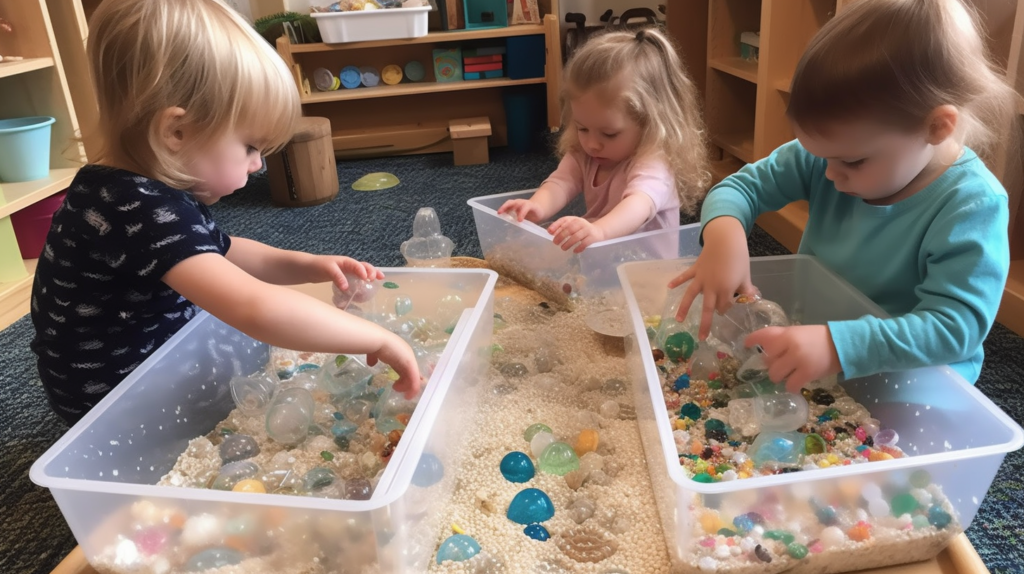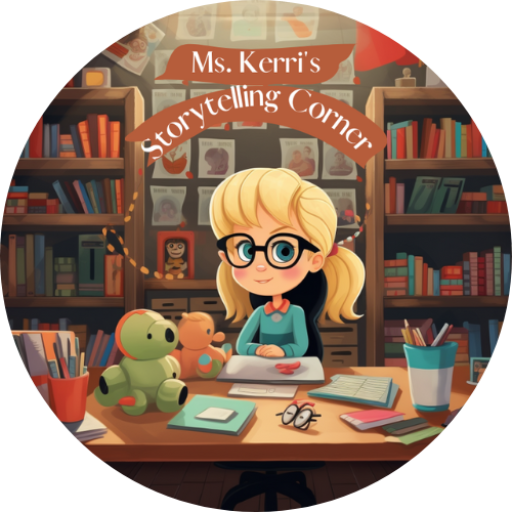Sensory bins are a fantastic way to engage preschoolers in play and exploration using everyday items. They provide a multi-sensory experience that stimulates learning and development. In this article, we will explore the benefits of DIY sensory bins and how they can be used to encourage language, cognitive, social, and emotional development in young children.
Key Takeaways
- DIY sensory bins promote hands-on exploration and learning through play.
- Engaging themes in sensory bins encourage creativity and imagination in preschoolers.
- Sensory bins support language development and cognitive skills in young children.
- Social interaction in sensory play fosters cooperation and empathy among preschoolers.
- Sensory bins provide opportunities for emotional learning and self-regulation in young children.
Choosing the Right Materials

Selecting Safe and Age-Appropriate Items
When creating sensory bins for preschoolers, the safety and appropriateness of the materials used are paramount. Always opt for non-toxic, large items that pose no choking hazard to young children. It’s essential to tailor the sensory bin contents to the child’s age and developmental stage, ensuring a safe and enriching experience.
Here’s a simple guideline to follow:
- For toddlers (1-2 years), focus on large, soft items that can be easily grasped.
- Preschoolers (3-4 years) can handle smaller, more complex items, but still avoid sharp edges.
- Older children (5-6 years) may enjoy items that challenge their fine motor skills, like threading beads or manipulating small figures.
Remember, the goal is to stimulate the child’s senses in a safe environment. By carefully selecting items that are both safe and age-appropriate, you can create a sensory bin that offers hours of engaging play.
Incorporating sensory items that vary in texture, color, and shape can significantly enhance the sensory experience. This variety not only stimulates the child’s tactile, visual, and auditory senses but also encourages exploration and discovery.

Exploring Textures and Sensory Stimulation
When creating sensory bins, the exploration of textures plays a pivotal role in stimulating a child’s tactile senses. Varied textures not only captivate their attention but also enhance their sensory discrimination skills. Incorporating a mix of smooth, rough, squishy, and hard items can provide a comprehensive sensory experience.
It’s essential to observe children as they play, noting their preferences and any sensitivities to certain textures. This observation can guide future bin creations, ensuring they are both enjoyable and educational.
For a more structured approach to introducing textures, consider the following list:
- Rice or pasta for a smooth and pourable texture
- Pebbles or small rocks for a rough and hard sensation
- Cotton balls or pom-poms for a soft and squishy feel
- Water beads or slime for a unique, slippery experience
By carefully selecting items that offer a variety of textures, parents and educators can create an engaging and developmentally beneficial play environment.
Creating Engaging Themes
Incorporating Nature and Outdoor Elements
Bringing the outdoors inside can create an enriching sensory experience for preschoolers. By incorporating elements from nature, children can explore a variety of textures, colors, and smells, fostering a deeper connection with the environment. Creating a nature-themed sensory bin is a simple yet effective way to achieve this.
Leaves, twigs, stones, and sand can be collected during outdoor walks and used to fill the sensory bin. This not only encourages children to engage with natural materials but also promotes physical activity and curiosity about the world around them.
Remember, it’s important to ensure all items are clean and safe for play.
Here’s a quick guide to setting up your nature sensory bin:
- Collect natural items during walks.
- Include items with varying textures for sensory exploration.
- Add small toys or figures to create interactive scenarios.
- Encourage children to share their findings and stories about their play.
Exploring Seasonal and Holiday Themes
Seasonal and holiday themes offer a treasure trove of opportunities for sensory exploration and learning. By incorporating elements that reflect the changing seasons or specific holidays, you can create a sensory bin that not only entertains but also educates.
For example, a fall-themed sensory bin might include items like colorful leaves, small pumpkins, and acorns. This not only introduces preschoolers to the concept of seasons but also allows them to explore different textures and colors. Similarly, a winter-themed bin could feature cotton balls for snow, shiny tinsel, and small pine cones.
Holiday-themed sensory bins can be particularly engaging. They provide a platform for discussing traditions and cultural significance, enriching the sensory play experience. Here’s a list of ideas for holiday-themed bins:
- Halloween: Spooky figures, black and orange items, textured fabrics
- Christmas: Ornaments, tinsel, scented pine cones
- Easter: Plastic eggs, artificial grass, bunny figures
By carefully selecting items that are safe and age-appropriate, you can create a sensory bin that is both fun and educational.
Encouraging Language and Cognitive Development

Promoting Vocabulary and Communication Skills
Sensory bins not only captivate the senses but also serve as fertile ground for language development. By integrating objects that relate to current themes or interests, children are encouraged to articulate their thoughts and questions, thereby expanding their vocabulary. This active engagement fosters both individual expression and interactive dialogue, making it a powerful tool for communication skill enhancement.
Interactive dialogue is key in promoting effective communication skills. Through the natural conversation that occurs during play, children learn new words and concepts, practice sentence structure, and develop listening skills.
Sensory bins can be easily tailored to include items that prompt storytelling or role-playing, further enriching the language learning experience.
Here’s a simple list of items to include in a sensory bin to encourage vocabulary development:
- Figurines representing different professions
- Natural elements like stones, leaves, or shells
- Everyday objects that relate to specific themes (e.g., kitchen utensils for a cooking theme)

Enhancing Problem-Solving and Critical Thinking
Creating sensory bins that challenge preschoolers to think critically and solve problems can be both fun and educational. By incorporating puzzles or tasks that require sorting, matching, or sequencing, children engage in active learning. This hands-on approach encourages them to explore solutions and understand cause and effect relationships.
Sensory bins can be easily adapted to suit different levels of difficulty, ensuring that children of all ages and abilities can benefit from the experience. For example, younger children might sort objects by color or shape, while older children could be tasked with more complex problem-solving activities, such as constructing a story from items found within the bin.
Sensory play is not just about touching and feeling; it’s about thinking and solving. It’s a multi-sensory approach to learning that supports the development of critical thinking skills.
- Examples of Problem-Solving Activities in Sensory Bins:
- Finding hidden objects
- Completing a puzzle with pieces hidden in the bin
- Sequencing story cards found in the bin
Facilitating Social Interaction and Emotional Learning

Promoting Sharing and Cooperation
Sensory bins are not just about sensory exploration; they also offer a wonderful opportunity to foster social skills among preschoolers. Creating a sensory bin that requires teamwork can encourage children to work together, share resources, and develop a sense of cooperation. For example, a bin designed for building a small village would need children to share materials like sticks, stones, and leaves to complete their project.
Sensory bins can be a platform for children to practice negotiation and turn-taking, essential skills in social interaction.
Here are a few simple tips to encourage sharing and cooperation through sensory bins:
- Encourage children to plan their sensory bin activity together.
- Use timers to ensure equal playtime for everyone involved.
- Praise and reinforce positive interactions and sharing behaviors among the children.
Supporting Emotional Regulation and Empathy
Sensory bins can be a powerful tool in supporting emotional regulation and empathy in preschoolers. By engaging in play that stimulates their senses, children learn to understand and express their emotions more effectively. Creating sensory bins with themes that encourage empathy—such as caring for animals or helping others—can foster a deeper understanding of these concepts.
Empathy and emotional regulation are critical skills that can be nurtured through thoughtful sensory play. Consider incorporating elements that require children to work together or share, promoting these essential social skills.
Sensory bins that include scenarios for role-playing can significantly enhance a child’s ability to empathize with others.
- Encourage sharing by including multiple sets of tools or toys.
- Introduce scenarios that require cooperation, such as building a structure or solving a puzzle together.
- Use themes that reflect real-life situations where empathy is required, like caring for a sick pet or helping a friend in need.

Conclusion
In conclusion, sensory bins are a fantastic way to engage preschoolers in creative and educational play using everyday items. By incorporating different textures, colors, and themes, children can explore, learn, and develop essential skills in a fun and interactive way. Whether at home or in a classroom setting, DIY sensory bins provide endless opportunities for imaginative play and sensory exploration.
Frequently Asked Questions
Are sensory bins safe for preschoolers?
When created with age-appropriate materials and under adult supervision, sensory bins are safe and beneficial for preschoolers.
How can I choose the right materials for a sensory bin?
Select materials that are non-toxic, free from choking hazards, and suitable for the child’s age and developmental stage.
What are some engaging themes for sensory bins?
Incorporate nature, outdoor elements, seasonal themes, and holiday themes to create engaging and varied sensory experiences for preschoolers.
How can sensory bins encourage language development?
Sensory bins can promote vocabulary, communication skills, and cognitive development through hands-on exploration and play.
What are the benefits of sensory bins for social interaction?
Sensory bins can promote sharing, cooperation, and emotional learning, supporting social interaction and empathy development.
Are sensory bins suitable for children with sensory processing issues?
With careful selection of materials and consideration for individual sensitivities, sensory bins can be adapted to support children with sensory processing challenges.


Ms. Kerri’s Corner provides a exciting virtual space for preschool learning. Through a variety of engaging activities, she exposes young minds to early math, literacy, science and social-emotional skills in a developmentally appropriate way. Centers for blocks, art, books and music allow children to explore hands-on learning at their own pace. Guided lessons subtly introduce number sense, letter sounds and narrative thinking. Careful observation gives insight into each child’s progress across domains. Viewers are also invited to participate, reinforcing that their ideas are valued. By making learning fun yet purposeful, Ms. Kerri lays the groundwork for future academic success while fostering creativity and imagination. Her program offers preschoolers valuable screen-based learning experiences.




